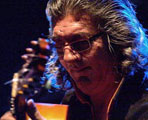The essence of Jerez in six strings that have been forever silenced
|
Text: Estela Zatania The news hits you like a bucket of cold water on a hot August morning. But instead of being refreshing, it leaves you without air, and your brain goes into a terrible shutdown. Death is always a surprise, even when, as in this case, it is expected. But sometimes it’s more surprising, like when it’s the son of Juan Morao, nephew of Manuel, without a doubt the most beloved individual of the long roster of flamenco artists in Jerez. Manuel Moreno Junquera would have been 55 next month. So young….
With the passing of our much-admired Moraíto, an important piece of Jerez, not just Jerez flamenco but the city of Jerez itself, has become a huge vacuum. Just as with Fernando Terrremoto last year, Manuel still had much to offer. On the purely human level, Moraíto, or Morao as we’ve been calling him lately, had an uncommon personality for a great flamenco artist. Simple, homespun, affectionate and good-natured, with his natural flamenco way of being, and no airs at all. This man, who for many was today’s greatest flamenco guitarist, could be seen any day of the week with his little cap and his basket, heading out to the country to hunt for wild mushrooms. He wasn’t the kind who moved to Madrid, he needed to be with his people and his neighborhood of Santiago. With this type of death everyone always talks about the “battle”, and other journalistic clichés. This time I couldn’t even bear to ask for people’s reactions, because I know all too well there are no words. In Santiago the silence is deafening. Just as it was in Morón the day Diego died, or in Utrera when we lost Fernanda, or here in Jerez when Paquera went. Gitanería, one of the flamenco meeting-places, was closed. Next door, the storefront that for a time was Moraíto’s guitar shop, is sad testimony to a future that was never to be. Outside the Zambo fish shop, lots of people are gathered, but instead of the noisy chatter and histrionic gesturing you see any day of the week, today there is silence. In Agustin’s bar, where Moraíto had his beers and tapas at midday, and mingled with people from the neighborhood, a television camera crew is filming the humble bar where the maestro spent half his life. The whitewashed walls of the little house across the street that has the image of a guitar next to the door are crying dust, and every siguiriya you ever heard is playing obsessively in your head.
The last time I saw him was a couple of months ago outside Gitanería. While Mateo Soleá, owner of the bar, dished out his homemade tomato soup, there was some singing and compás as sometimes happens. Morao, gravely ill by then, danced bulerías, that little dance of his, and the mischievous smile and dimples revealed how much he loved life. I saw that same face four decades earlier on TV in 1973 at Casa Pepe in Morón de la Frontera, on one of the few television sets there was in town at the time. It was an episode of Rito y Geografía del Cante, and Moraíto Chico, as he was known at the time, at 16, was playing siguiriyas for Antonio Malena, five years younger than himself. Gut-wrenching essence from these children who had barely lived twenty years between the two of them. The permanent sidekick and guitarist of José Mercé leaves us his son Diego, an accomplished professional of the guitar. He also leaves behind numerous collaborations on recordings, and two solo records, “Morao y Oro” (1992) and “Morao, Morao” (1999, re-released in 2005). Among other honors, he was awarded the Copa Jerez of the Cátedra de Flamencología, and the Giraldillo a la Maestría of the last Bienal de Flamenco de Sevilla as a result of his participation in September in Miguel Poveda’s inaugural show “Historias de Viva Voz”. His last complete recital took place at the Nimes Flamenco Festival in January of this year. That same week, at the Dutch flamenco Bienal an excellent documentary was shown for the first time, “El Cante Bueno, Duele”, a production of the organization of that event in which Moraíto was the central figure, leaving testimony of his art and of the flamenco ambience of his family and city. Every day we’re told that flamenco is never going to end. And surely this is true. As surely as the fact that we will never again hear this brilliant guitar full of expressive subtlety and rhythm, the essense of Jerez in six strings and in the persona of Manuel Moreno “Moraíto” for posterity and forever, my dear friend.
|
